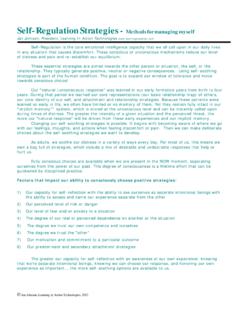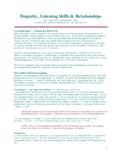Transcription of Self-Regulation Strategies - Methods for managing myself
1 Jan Johnson, Learning In Action Technologies, 2003 Self-Regulation Strategies - Methods for managing myself Jan Johnson, President, Learning In Action Technologies Self-Regulation is the core emotional intelligence capacity that we all call upon in our daily lives in any situation that causes discomfort. These conscious or unconscious mechanisms reduce our level of distress and pain and re-establish our equilibrium. These essential Strategies are aimed towards the other person or situation, the self , or the relationship. They typically generate positive, neutral or negative consequences. Using self -soothing Strategies is part of the human condition. The goal is to expand our window of tolerance and move towards conscious choice! Our "natural (unconscious) response" was learned in our early formative years from birth to four years. During that period we learned our core representations (our basic relationship map) of others, our core identity of our self , and attachment and relationship Strategies .
2 Because these patterns were learned so early in life, we often have limited or no memory of them. Yet they remain fully intact in our "implicit memory"* system, which is stored at the unconscious level and can be instantly called upon during times of distress. The greater the intensity of a given situation and the perceived threat, the more our "natural response" will be driven from these early experiences and our implicit memory. Changing our self -soothing Strategies is possible. It begins with becoming aware of where we go with our feelings, thoughts, and actions when feeling discomfort or pain. Then we can make deliberate choices about the self -soothing Strategies we want to develop. As adults, we soothe our distress in a variety of ways every day. For most of us, this means we own a bag full of Strategies , which include a mix of desirable and undesirable responses that help or hurt us. Fully conscious choices are available when we are present in the NOW moment, separating ourselves from the power of our past.
3 This degree of consciousness is a lifetime effort that can be quickened by disciplined practice. Factors that impact our ability to consciously choose positive Strategies : 1) Our capacity for self -reflection with the ability to see ourselves as separate intentional beings with the ability to access and name our experience separate from the other 2) Our perceived level of risk or danger 3) Our level of fear and/or anxiety in a situation 4) The degree of our real or perceived dependence on another or the situation 5) The degree we trust our own competence and ourselves 6) The degree we trust the "other" 7) Our motivation and commitment to a particular outcome 8) Our predominant and secondary attachment Strategies The greater our capacity for self -reflection with an awareness of our own experience; knowing that we're separate intentional beings, knowing we can choose our response, and honoring our own experience as the more self -soothing options are available to us.
4 Jan Johnson, Learning In Action Technologies, 2003 self REULATION Strategies Alone or Relationship -- self or Other Focus Positive or Neutral Negative or Neutral ALONE FOCUS Apart from Relationship Consciously attend to breathing-relaxing Exercise Movement Awareness of body sensations Attending to care for my body--nutrition Meditation & Prayer self expression --art, music, dance, writing, etc Caring, nurturing self -talk Laughing - telling jokes Positive self -talk "I can" "I'm sufficient" messages Go inside with intentional nurturing of self Addictions of all kinds (food, drink, drugs, etc) self imposed isolation Negative self -talk "I can't" "I'm not sufficient" messages Disregard for own safety -- participate in high risk behaviors Go away from the situation, daydream, think about something else to escape Sabotage self , give up Physically hurt- wound the body Positive or Neutral Negative or Neutral RELATIONSHIP FOCUS On OTHER In relationship Seek dialogue & learning Play with others Shared humor Move towards the relationship to learn- mutual inquiry Desire and/or movement toward collaboration Intentionally honor or celebrate the other -- call attention to the other Dismiss the other person Want to withdraw or walk away Blame others Go away from feelings and think about the other person as a problem to be dealt with Feel powerful, like a victim of the other Wanting to sabotage or hurt the other Just leave the relationship -- quit Honor and call attention to the other.
5 Denying self to do so RELATIONSHIP FOCUS On self In relationship Acknowledge what I said or did and any truth in it Humor Move towards the relationship to learn Desire for collaboration Inquire about impact Intentionally honor or celebrate self -- throw myself a party Feel badly about myself and/or responsible for this person Negative self talk about my worth or value in this relationship Feeling shame with wanting to withdraw Take responsibility for what went wrong (as a normal stance) Go to another person or group to talk about the "other" and to be soothed by others Feels powerless to make changes in relationship -- tends to withdraw Tell myself I'm not enough -not sufficient or the relationship, the problem



